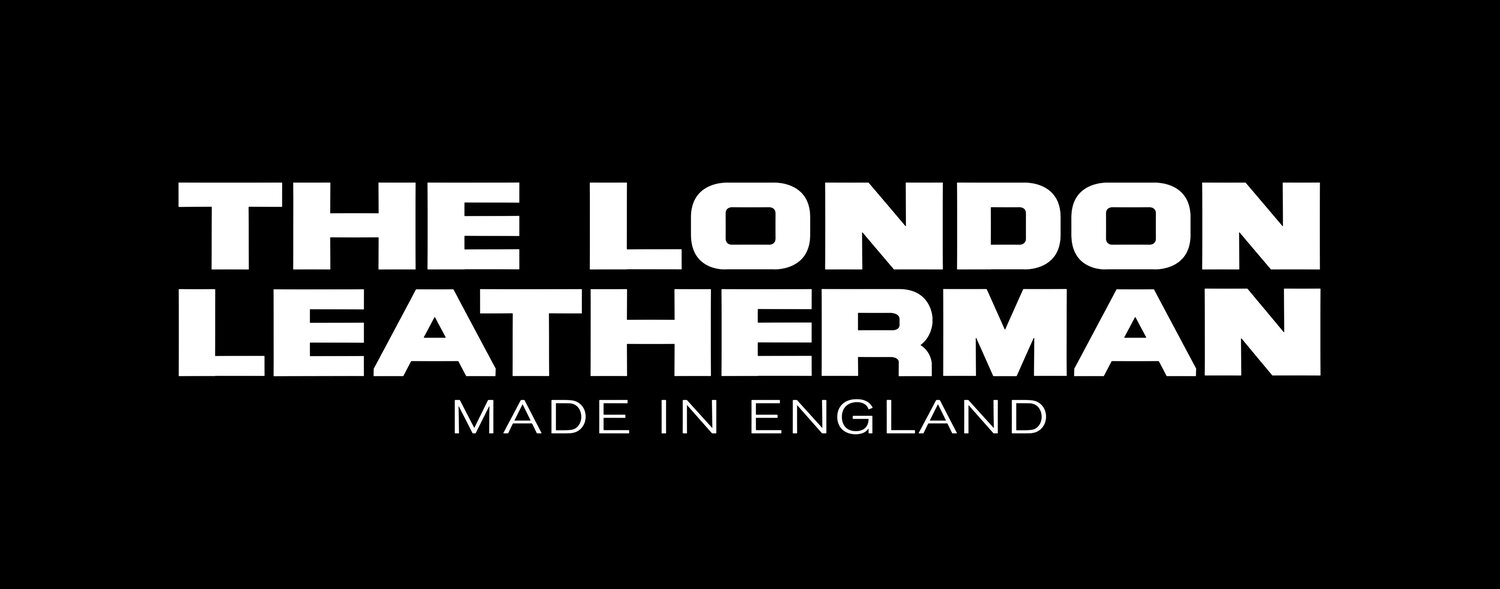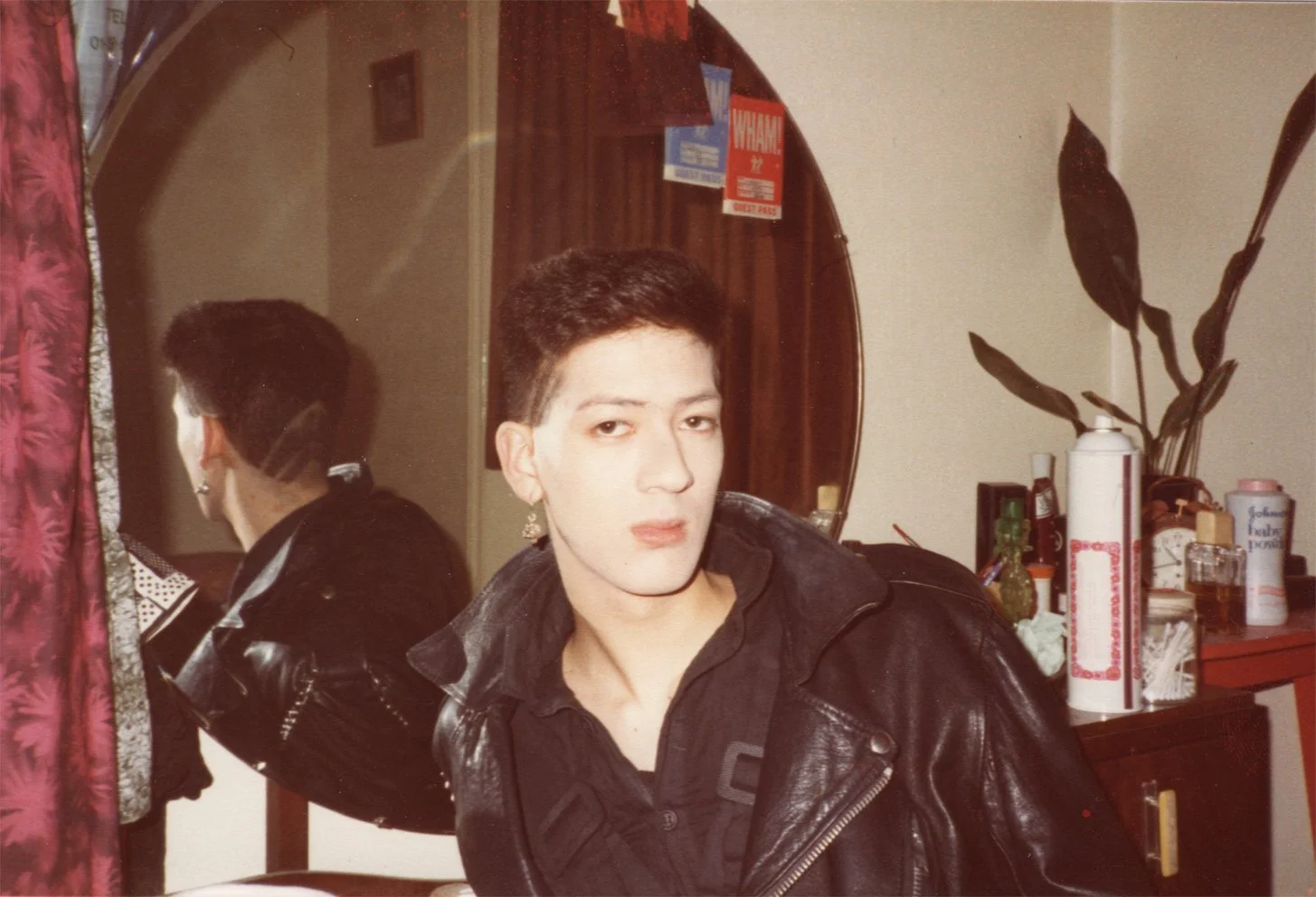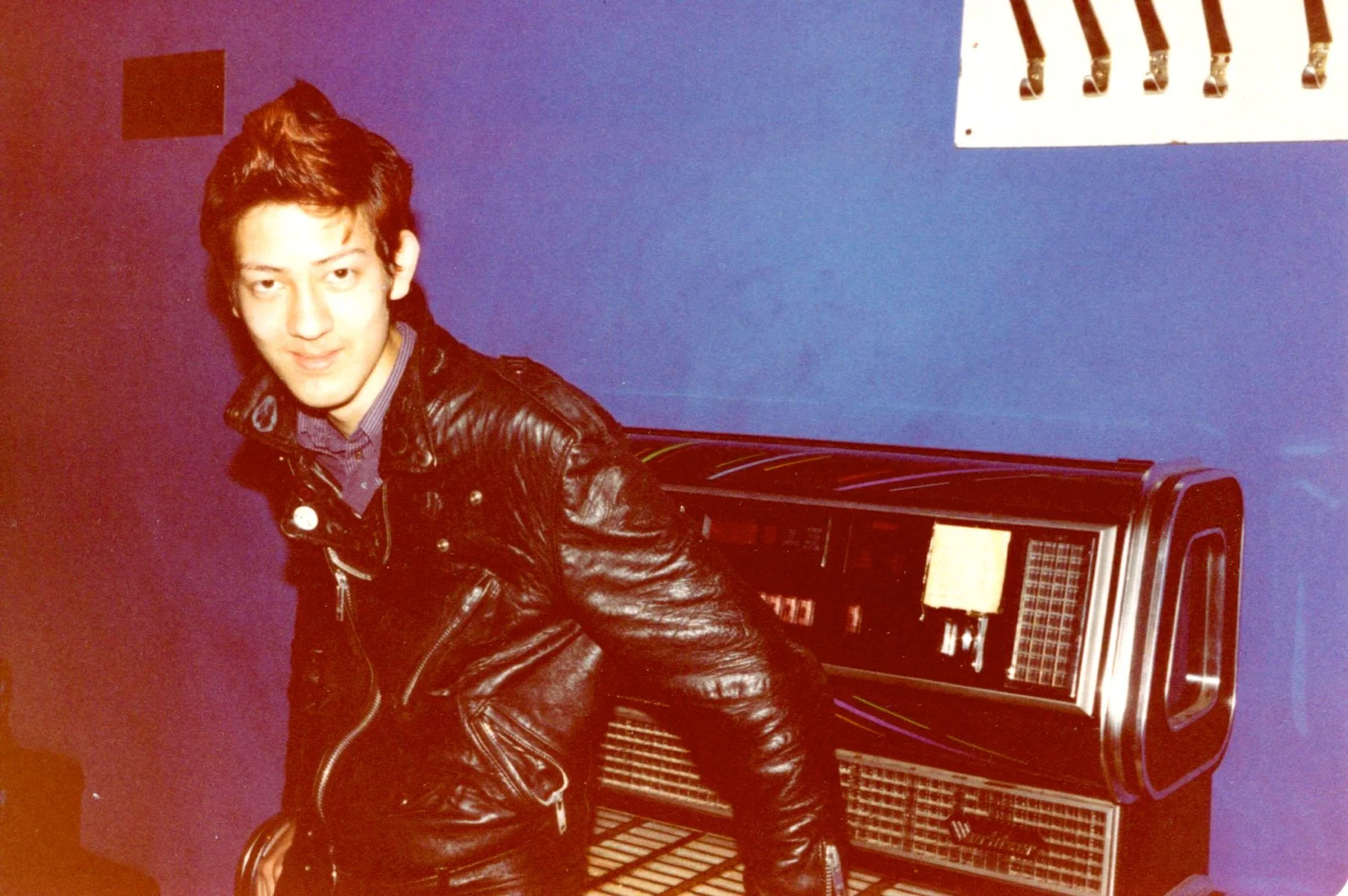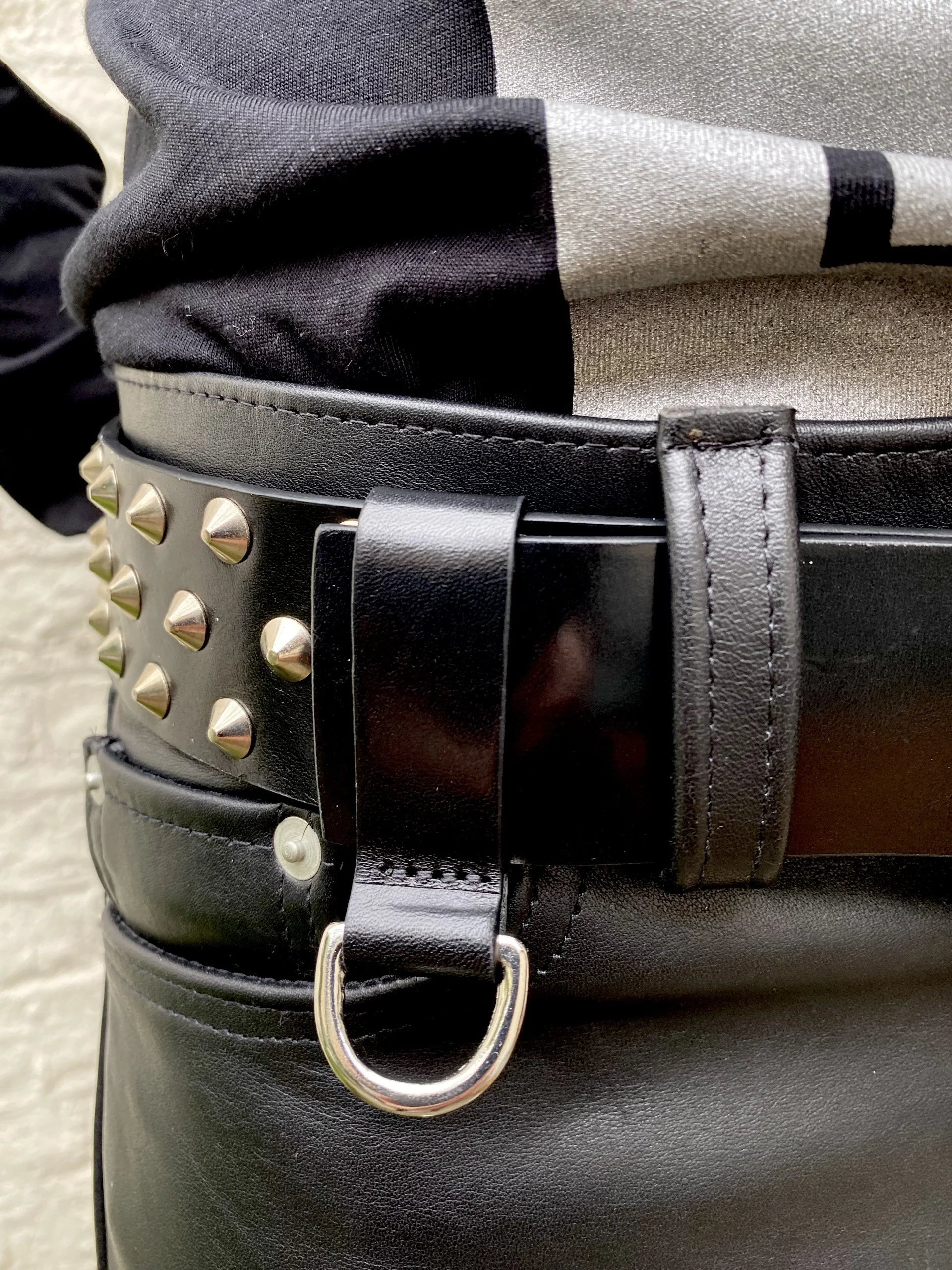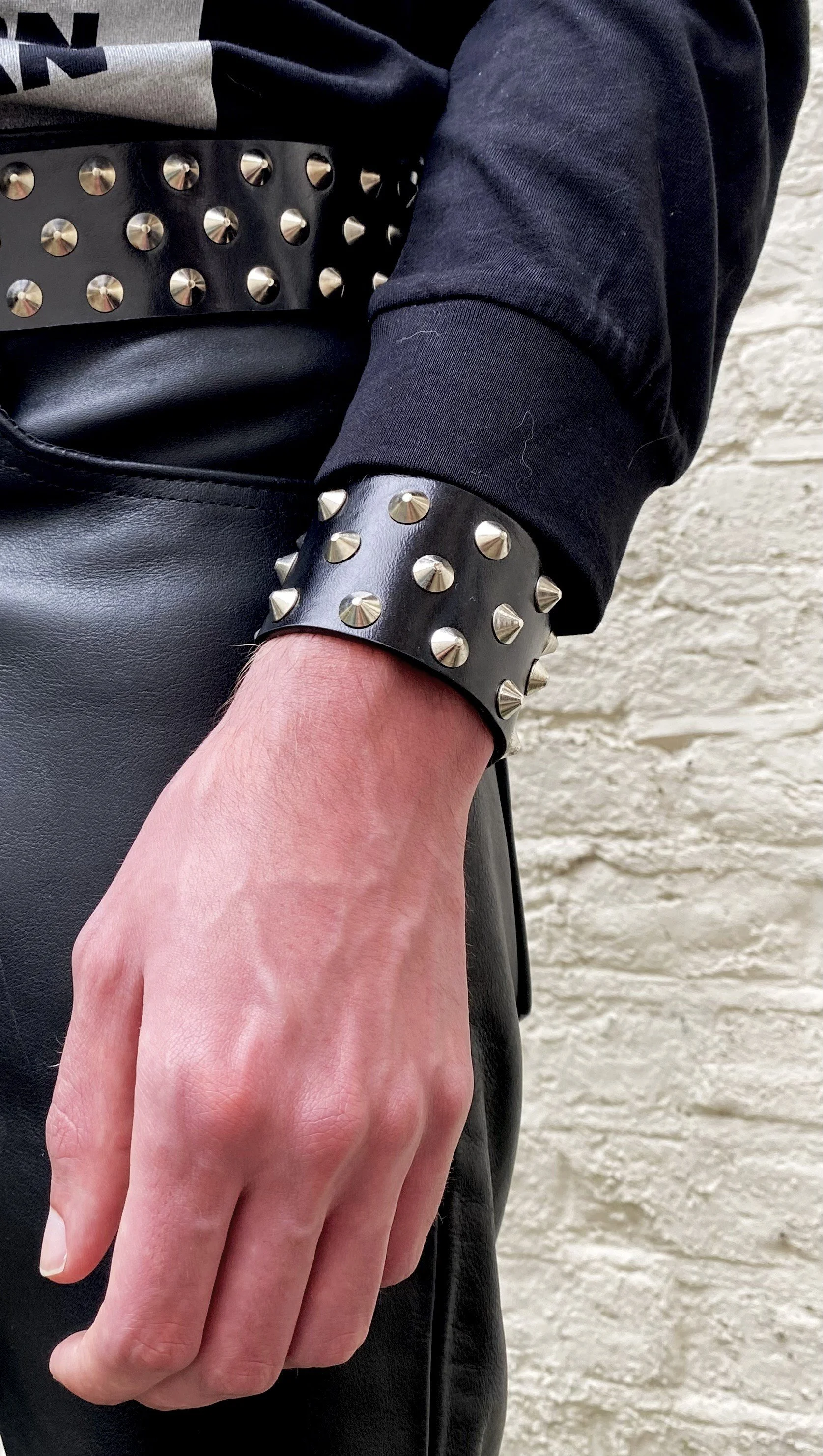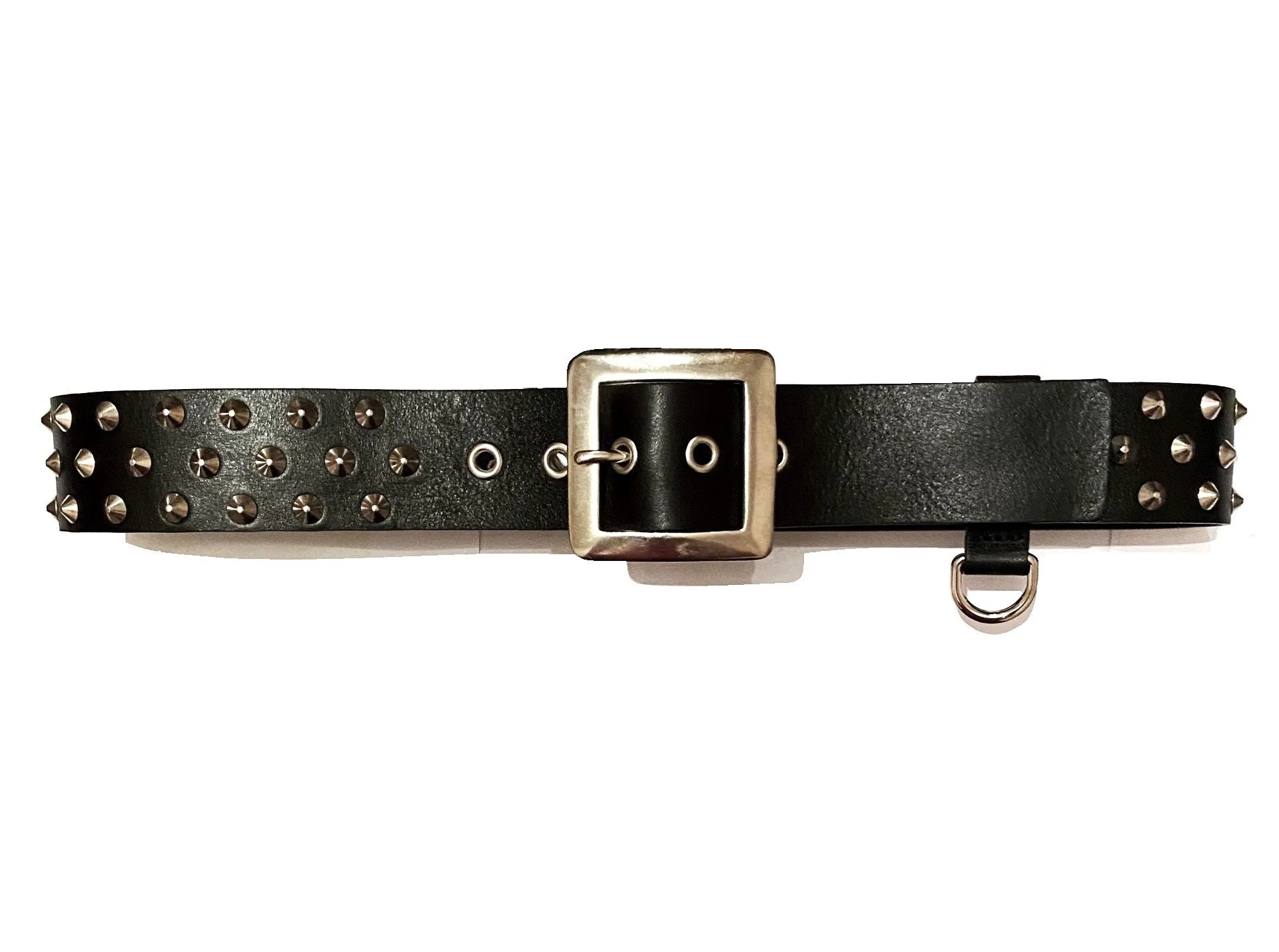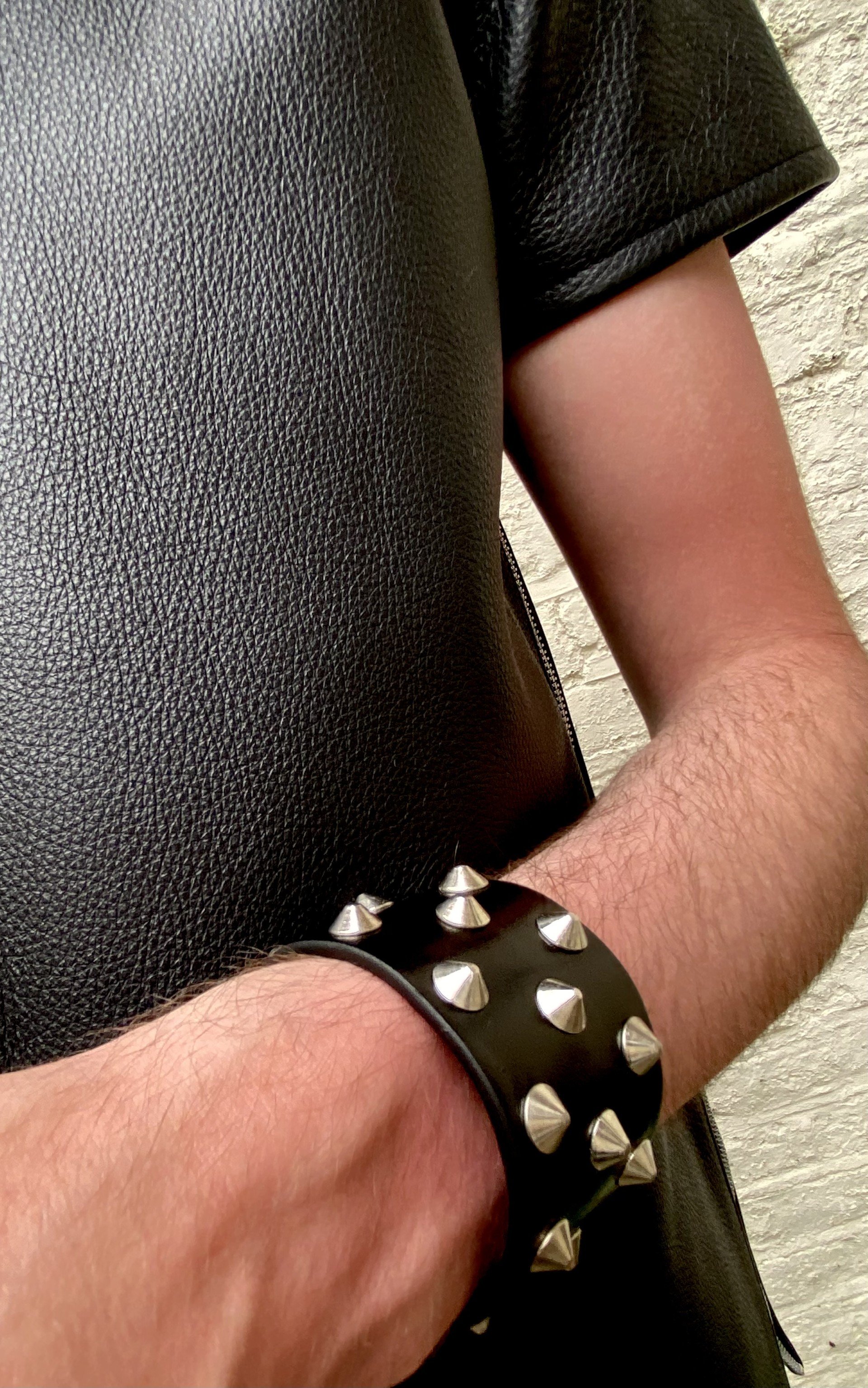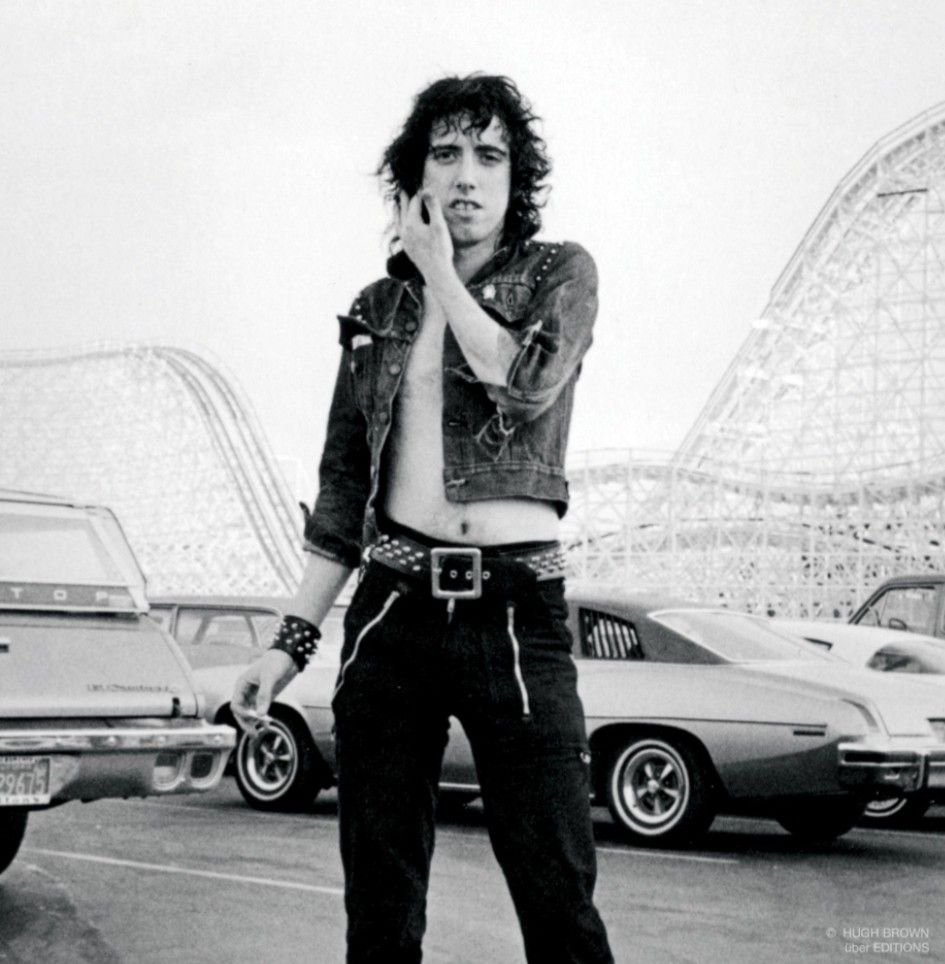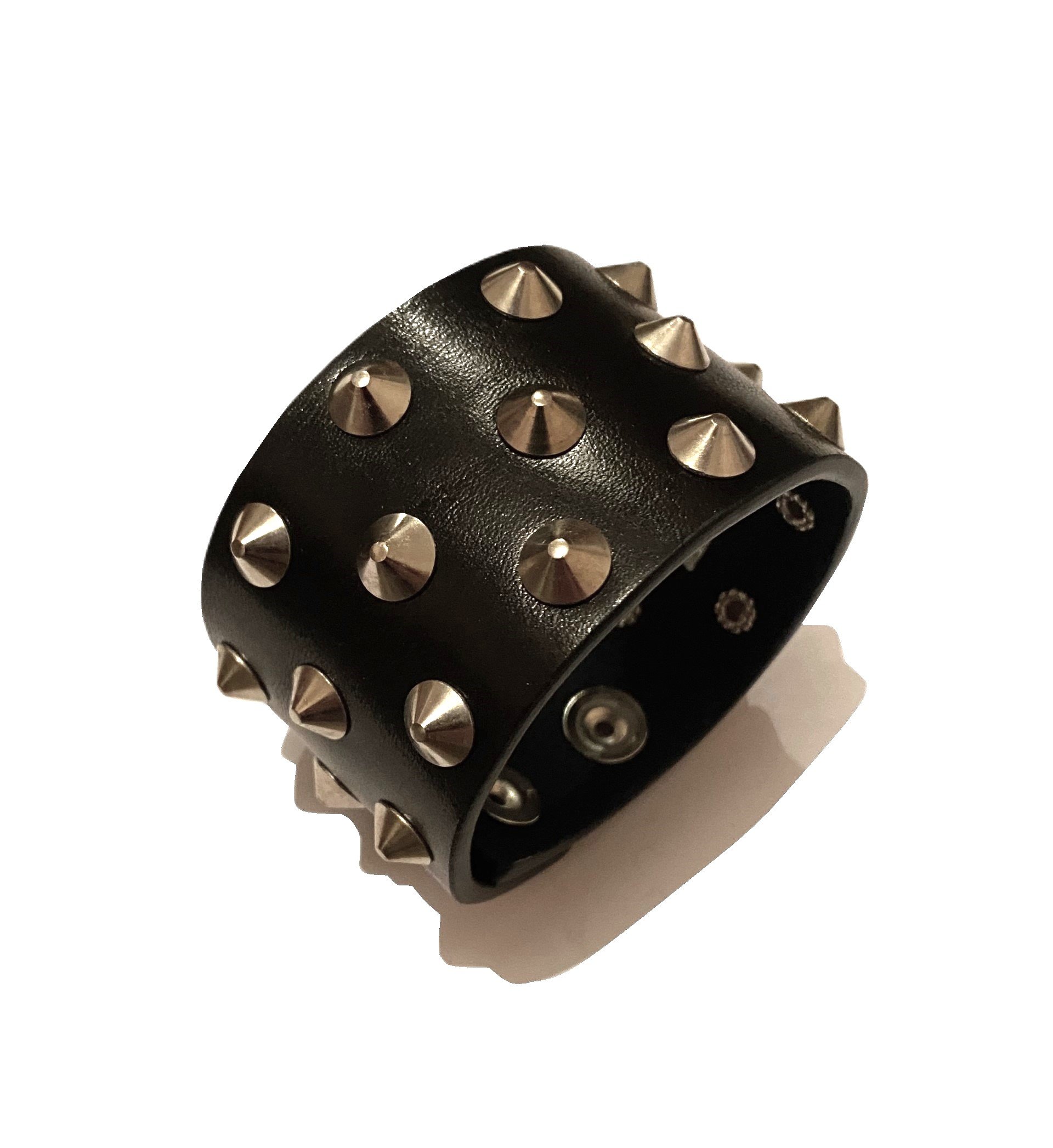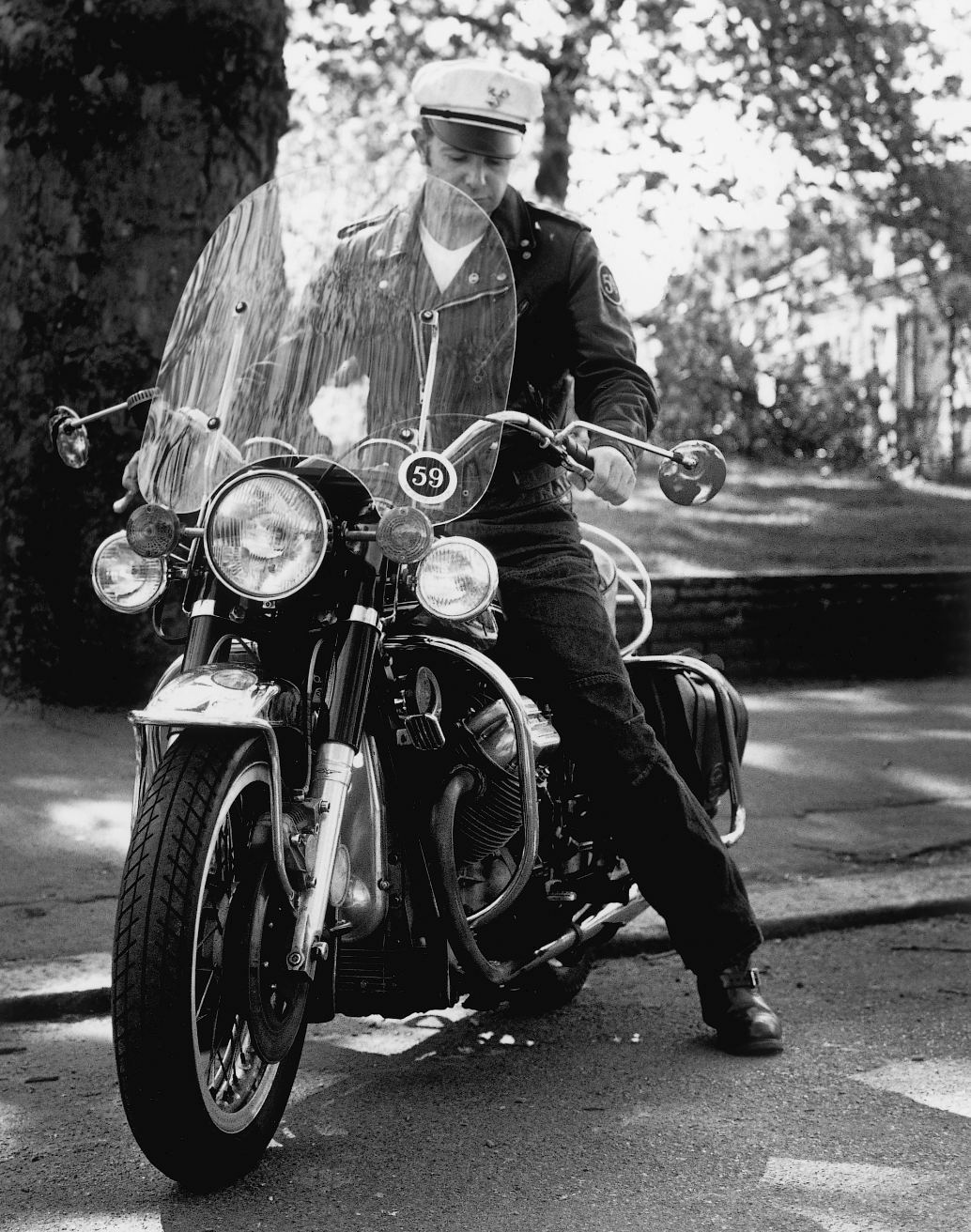The 1976 Look
Collaborator Profile- Slim Jim Phantom
Slim Jim Phantom, the legendary drummer and rockabilly icon reflects on his neo-rockabilly style by answering 9 hot-fire questions before heading off on tour with his band the Stay Cats next week.
Questions by Dave Carroll
Edited by Bridget Veal
Q. Pre-forming the Stay Cats what was your scene, what was your style or a memorable outfit you’d wear?
A. Pre Stray Cats I was into mainly jazz and blues and I always loved the Beatles. I would always seek some kind of alternative clothing like an old fedora hat taken from an uncle's closet or one of my father’s neck ties and wear it with whatever else I had. I wore a referee’s shirt that was given to me while refereeing my sister’s soccer game with the aforementioned tie and hat.
Q. What influence would you say punk rock had on you?
A. Punk was good for the energy and it showed that styles could be combined. There was definitely some Eddie Cochran in there.
Q. In 1979 punk rock had run its course for kids like me and there was a moment where we didn’t know where to go when New Romantic, goth, disco and the soul scenes didn’t resonate. It was when I went to a rocking club, the St. Helier Arms in South London and saw kids still wearing their old punk T-shirts but with 1950s box jackets, chucker boots and pegs being the order of the day that I knew we’d found our new scene. Hair was no longer spiky but styled into bleached flat-tops or crazy-colour quiffs, what was your first rockabilly haircut?
A. My first rockabilly haircut was a big greasy pompadour. I was completely into the Elvis Presley look and style from the Sun Records era and anything I did was trying to achieve that look.
Q. Your gig at the Lyceum Ballroom 1981 was the epitome of the Stray Cats spearheading the rockabilly revival in London, is there anything about this gig or 1981 in London you can remember and your fans may be surprised to read?
A. 1981 was awesome! London was so happening and I was thrilled to be welcomed everywhere. An unintentional bonus of being in the Stray Cats was that we were embraced by all the different tribes. I went to every type of club and gig. I knew the doormen at every joint in town and went to every night of The Cash residency at the Lyceum that year. We also did a video with Dave Edmunds at the Cats soundcheck before one of our gigs there.
Q. Neo-rockabilly was a glamourised version of the rockabilly scene that had been before, we weren’t restricted to wearing only old (vintage) 50s clothing or homemade clothing like kids on the rocking scene would. Shops like Johnsons La Rocka! were designing almost caricature versions of clothing for rockers that could be styled with vintage clothing and looked amazing. What clothing shops did you shop at when in London?
A. I loved Johnson’s on Kings Rd, Lloyd is my close friend to this day. He thought we must be French rockers when he first saw us! I got a lot of stuff at Robot, especially shoes and also some great vintage pieces from Kavan at American Classics. My dear pal Peter Golding had Ace and 151 both very cool spots.
Q. Your not opposed to wearing gold leather. If you had to choose between a gold leather jacket and a black leather jacket, what would you choose and why?
A. Black is more classic and it goes with more outfits. That gold leather jacket definitely IS the outfit when you wear it.
Q. When you think of The London Leatherman what comes to mind?
A. The London Leatherman had that awesome leopard skin waistcoat! I wore it 1,000 times.
Q. Other than Elvis’ 68 Comeback Special look, who in your opinion is the best leather wearing rockabilly?
A. Gene Vincent really rocked the leathers!
Q. You’re about to head off on tour with the Stray Cats, what will you be wearing?
A. On the upcoming Stray Cats tour I'm going to wear a custom made classic western styled rockabilly suit. It's made of the best gabardine I could find and it’s got red diamond inlays with saddle stitch. It’s a shorter cut bolero style jacket. I’ll be sporting a few custom made sleeveless, cowboy shirts with coloured fringe made by my wife bassist and fashion designer Jennie Vee, red creepers and a bandana, of course!
ARCHIVE vs NEW The LV4 Jean Style Jacket
The LV4 Jean Style Jacket is the classic The London Leatherman jacket that’s transcended time. Shown in the first catalogues from the 70s in illustration form and in 1980 guitarist Marco Pirroni (of Adam & The Ants fame) wore it to perform with the post-punk band the Weekend Swingers. The London Leatherman archive holds custom versions of the LV4, some with posing pockets, some with leather lacing up the sides and crafted in a thick steer hide.
Today two versions of the LV4 are in production the Classic LV4 featured in stills from the short film Ajamu (2019) by Stephen Isaac Wilson and the Vintage Fit LV4 sported by art-pop duo Faux Real.
Collaborator Profile- Marco Pirroni
No one quite knows clothes like Marco Pirroni knows clothes. He was dressing like a punk rocker before the term punk rock was coined, unintentionally influenced the New Romantic style and had a collection of clothing from the Kings Road in the 70s that most could only dream of. Marco and Dave Carroll have clocked up hundred of hours talking about clothes since they were introduced back in the 90s. He’s best known as the lead guitarist and co-song writer of Adam and the Ants.
Questions by Dave Carroll
Edited by Bridget Veal
Q. Do you remember buying any leather clothing or leather accessories on the Kings Road in the 70s?
A. Yes
Leather trousers
T-shirt
Jackets
Wristbands
Belts
You name it!
Q. What’s your perspective on what a studded belt or studded wristband meant to a punk rocker?
A. The wristbands from SEX (430 Kings Road) were certainly a symbol of punkness.
Q, At what moment did you know you wanted to be a guitar player in a band? And who would you say have been your biggest inspirations, or influences on your career as a guitarist?
A. Soon as I heard Mick Ronson on Alladin Sane. I had been teaching myself at home, but it was that album that made me think of doing it seriously.
Q. Was there any other punk rocker you know of that was more into their clothes than you were? Someone who bought as much as you did, someone truly invested in buying and savoring their kit?
A. Lots of people.
Q. We had your collection of SEX & Seditonaries gear photographed in the 90s, these photos are somewhere, we must find them. Of everything you bought from Maclaren & Westwood what were you favourite pieces and why?
A. I loved the blue coat and pink loafers. The loafers fell apart.
Q. The London Leatherman accessories sold at SEX & Seditionaries were displayed on wooden gymnastics frames on the right as you entered the shop. How impactful was this display of leather accessories with studs and chains?
A. They added to the kinky rock and roll atmosphere.
Q. Who looked better in leather the rock’n rollers, glam rockers, punk rockers or the post-punk 80s scenes?
A. Dirk Bogarde.
Q. Did you ever go to the The London Leatherman shop on Queenstown Road?
A. Yes.
Q. A real punk rock piece of The London Leatherman clothing is the ciré wet look nylon (LN6) T-shirts that were sold to SEX, Seditionaries, Smutz, BOY, loads of shops with their own labels sewn in. In 1978 I had them in black and in navy blue. Did you have one? If yes, in what colour?
A. Yeah, everyone had them. I had a black and a red one.
Q. Shoes are your thing. What’s the best designed shoe in your opinion and why?
A. The Justin Roper boot.
Q. If you had to pick just one memorable look you’ve self styled, what was it (the clothes, accessories & shoes), when did you wear it and do you have a picture?
A. I can’t pick one, I also looked fucking stupid a lot of the time.
ARCHIVE- The LG6 Leather Chaps
The classic The London Leatherman style has a strong Western cowboy influence and leather chaps play right into this look.
The LG6 Chaps are the most identifiable as being by The London Leatherman with their rounded waist detail, leather lacing and Lightning zips. They were of course popular on the fetish and leatherman scenes, were popular with motorcyclists for practical reasons but also had their 'in-fashion' moment with rock and pop stars of the 1980s.
Upon co-founding the band The Creatures with Siouxsie Sioux, Budgie (Peter Clarke) regularly wore his LG6 Chaps for photo sessions with a sheer LN6 Tshirt in white, circa 1983.
Collaborator Profile- Michael Costiff
Michael Costiff is the London face who’s inspired, influenced and worked alongside some of the most celebrated fashion industry greats. He’s the man behind the clothing boutique WORLD (and later WORLDArchive in Dover Street Market), he founded the club night Kinky Gerlinky with his late wife Gerlinde and in 2002 the V&A Museum monumentally acquired 178 outfits (almost 300 pieces) from their personal collection of clothing, referred to as The Costiff Collection.
In 2013 he released the retrospective book Michael and Gerlinde’s World: Pages From a Diary and he still owns his studded leather wristbands from when he was a punk rocker.
Questions by Dave Carroll
Edited by Bridget Veal
Q. You were a Kings Road mover and shaker in the 70s & 80s. What brought you to London and what was the catalyst that got you to gravitate towards and want to spend time on the Kings Road, Chelsea?
A. I come from a small (and then remote) village in the Peak District National Park in Derbyshire. I had a magical country childhood. I was always interested in fashion, art and music, so there was nothing of that for me there. I headed down to London (on the bus) to look for a job and on a beautiful sunny day in June 1969 I started work at I Was Lord Kitcheners Valet right in the heart of the Kings Road when the whole world was looking at Chelsea. Wow, it was so exciting, better than anything I ever imagined, all dolly birds, sports cars, Afghan coats, velvet loons, scarf-dresses....and bells!
Q. Before founding The London Leatherman Ken was the silent partner of Emmerton & Lambert the store in Chelsea Antique Market frequented by The Rolling Stones, The Small Faces and everyone who was anyone down the Kings Road. You ran a cafe in the Chelsea Antique Market? When was this and can you offer any insight to the atmosphere in the market at this time?
A. By 1971 I had a stall in Antiquarius in the Kings Road, but in 1972 we moved down the road and took over The Terrace Cafe in Chelsea Antique Market. Vern (Lambert) and Adrian (Emmerton) shared the top floor with us, although Adrian pulled out pretty soon after we arrived, and sort of disappeared? (*) Vern was an absolute genius and a lovely sweet and kind man and enviously knowledgeable. It really was the golden age of antiques and he was one of the first people to start selling antique and vintage fashion (it was unheard of before). He had the most amazing and beautiful stock, which I have never seen surpassed. I remember all those old Chelsea divas struggling up the stairs with armfuls of beaded dresses, exotic furs and embroidered robes to show Vern. We always had lots of fun every day with Ulla, Jenny Kee and Louise Doktor his glamourous staff and on sunny summer days our outside terrace was packed. Vern’s was a must visit destination for EVERYBODY who was happening on the scene at that time, and they all needed a coffee, so seeing people like Nureyev, Amanda Lear, Penelope Tree, Quentin Crisp, Verushca, Manalo Blahnik etc. everyday seemed quite normal. We had a blast!...We still stayed friends with Vern and Anna up until their deaths and even went to visit them in Italy.
(*Note for context: Adrian Emmerton was Ken’s boyfriend for 15+ years, he left the Emmerton & Lambert stall in the early 70s to start the clothing label South Sea Bubble Ltd. By 1971 Ken had already started The London Leatherman. Their time with Emmerton & Lambert was very much the 60s, the mid-60s being particularly electric with Ken making the clothes for the stall, we’re talking Jimmy Hendrix’s purple velvet trousers, Brian Jones’ cravat shirts...)
Q. As a punk rocker, did you ever wear any leather or studded leather? If yes, what? Where did you buy it and what in your opinion was the significance of wearing leather as a punk?
A. I was in my late twenties when Punk appeared, so hardly a "disaffected" youth, but I loved the fashions. I felt like a million dollars in my bondage suit. We snapped up loads from SEX and Seditionaries. We lived just down the road from Worlds End (and still do), so it was all going on right on our doorstep. Exciting times! Had lots of studded wristbands (still have them) but can’t remember where I bought them, probably Beaufort Market. The perfect accessory.
Q. You and your wife Gerlinde were prominent faces on the London club scene particularly in the 80s & 90s. I went to your club night Kinky Gerlinky a couple of times, one night it was for Planet Kinky where I was painted blue and dressed in a Star Trek outfit, looking nowhere near as outrageous as the other revelers. If you were to pick just one memorable night at Kinky Gerlinky, what was it and what did you wear?
A. Gerlinde and I were reluctant club promoters. What started as a party for friends grew into a monster. We ran the club from 1989 until 1994 and had a ball! We did 42 nights!
One Night that stands out was THE DAZZLE BALL at The Empire Ballroom, Leicester Square,with the biggest dancefloor in Europe. It was our Charity event for Aids charities and attracted 2,500 fun lovers. We had cabaret performances by Sinead O Connor, Neneh Cherry, Boy George, Nina Hagen, Nick Kamen and more. The atmosphere was so joyous and electric, a truly memorable night.
When I look back I realise what a huge operation it was, how did we do all that? But everybody was up for it, so it seemed easy.
Q. What club night, other than your own, was your favourite and why?
A. The first London club night we went to was Yours & Mine at the Sombrero in Kensington High Street. We went out a lot. Billy’s, Hell, Maunkberry, Blitz, Cha Cha, The Embassy, Camden Palace, Wag, Taboo, Daisy Chain, Queer Nation...lots of good times.
Q. Your shop WORLD was fantastic, what comes to mind for me is that it was a shop where high-brow street culture from all over the world collided with rave. How do you synopsize WORLD to anyone just discovering it?
A. Attached are a couple of press pieces about WORLD....I think they tell you enough.
Q. There’s no getting away from your style icon status. What would you say is the most significant look you’ve self-styled? The clothing, accessories and shoes worn. When did you wear it, why does it resonate and do you have a photo?
A. The clothes that Rei Kowakubo (Comme des Garçons) designed for me to model in her Paris Catwalk show.
2007, Michael Costiff wearing clothes designed for him by Rei Kowakubo of Comme des Garçons. Photographer Junichiro Tokumasu.
Q. Portobello Market on a Friday, what does it or what did it mean to you?
A. I think I’ve been going there ever since I arrived in London and still do. You can still always find something and I know I will always bump into people I know. Strolling down the market on a sunny day is always a pleasure.
Q. Who would you say has been the biggest inspiration or influence on your career in fashion and culture thus far?
A. I like good manners and kindness. I’m always attracted to people who do their own thing, no matter how wacky, I like positive energy.
Q. Are you currently working on any projects you can disclose here?
A. I like to be busy so I always have lots of projects going on, but never "go public" until they are complete.
Studded wristbands ‘The perfect accessory.’ Michael Costiff a Kings Road resident took this photo of Vivienne Westwood inside her shop Seditionaries, 430 Kings Road, with The London Leatherman wristbands and armbands displayed in cabinet.
Bespoke Coloured Leathers
This Summer 2024 have your The London Leatherman clothing made bespoke from our selection of six coloured cow hide leathers.
From claret red, to terracotta red, blue, navy blue, cowboy tan and brown we’d be happy post you a leather swatch of the colour(s) you’re interested in before putting your item into production.
Order as normal and we’ll correspond with you via email to confirm your colour choice. Email any queries through to info@prideandclarkelondon.com
Collaborator Profile- Nigel Smutz
Nigel ‘Smutz’ Brickell is the entrepreneur who opened the punk rock shop Smutz in Beaufort Market on the Kings Road during the height of punk. A larger than life character who had his finger on the punk rock pulse and would visit The London Leatherman to order and buy stock.
Questions by Dave Carroll
Edited by Bridget Veal
Inside the shop Smutz with model wearing a LN6 Ciré T-shirt in black wet look nylon which Nigel would order along with studded belts from The London Leatherman.
Q. As a teenage punk rocker Smutz was my (like many young punk rockers) prelude before working up the courage to go into Seditionaries, it was where you could go to get your punk rock look together, where you’d hear about gigs and what was happening on the scene, it was a real hang out. How do you describe Smutz to anyone just discovering its history? When did you open? And what was the spark that lead you to opening Smutz?
A. I left my home in Dorset at 18 to go to the London School of Printing to study. I come from an old print family. The only thing that interested me was screen printing. I had a small grant and to supplement it I had cycled around the East End and discovered vintage clothing warehouses so I bought wholesale and sold to friends and also had a stall in Portobello Market, around 1975.
On leaving the L.S.P I didn't want to return to sleepy Dorset so took a small downstairs stall in Beaufort Market, (which was) then an antiques market.
I used to shop in Acme Attractions and became friends with Don Letts and Jeannette, also John Kirvine the owner and Steph Rayner and his partner Helen. This is where I first heard about the Sex Pistols.
I had been into (the shop) SEX and purchased a pair of red Winkle Pickers on a cold Saturday at closing time and liked some of the pricey clothes.
As the punk thing was developing I took an upstairs stall in Beaufort Market with Mike McManus, later of (the shop) Robot, and we bought old stock ourselves and from Dave Fortune. After a while, Mike, not into the punk scene, teamed up with Dave to form Robot.
When the rumblings of punk started I had a friend James Holdsworth who had just left Chelsea Art School and he was interested in the screen printing I was doing, and with our friend James Henderson we started designing our own prints and also manufacturing punk clothing. They were my best pals, and still are from those days. To be honest it was one five year long party!
Whenever I encountered any problems I had an ace in my pack, John ' Biffo ' Bindon. John and I were good…umm acquaintances, he was everything the edit portrayed him as, a hard man gangster. He helped me out of a few situations. Through him I became friends with Richard Coles, Zeppelins tour manager and then Jimmy Page. One afternoon in the shop I was with Les McKeown of Bay City Rollers, Jimmy came in and I introduced them and we all went off for an afternoon of fun together. A very strange combination but they were both superstars in their fields. Another good friend was the great News at Ten Reggie Bosanquet. I from the early days of the Roebuck (pub on the Kings Road) knew the landlord Jack Hayes aka fat jack. The downstairs bar at weekends was usually full of 60s rockers, Zeppelin, the Who etc and whizz kid ad men like John ' Kings Road Cowboy' Cigarini. John became a great and still is friend, he knew everybody who was anybody from the music and film business. Fat Jack knew my crowd of punks, some underage and took me aside one day and said I have a empty function room upstairs, can you get your punk crowd up there? He did not realise that he had let the genie out of the bottle! It was not long before it (the Roebuck pub) was wall to wall with young attractive punk girls and us dudes. And then the rockers one by one ventured up and realised that's where it was happening. I first met Marianne Faithful up there and Phill Lynott, the great Frankie Miller, Mitch Mitchell, Chris Stamp The Who manager Terence Stamps brother. It was sex, drugs and rock and roll heaven!! And Reggie Bosa quite loved it, he lived very nearby. I often played pool with him, drinking, then getting a last minute taxi to present the News at Ten, slurring his way through it, sometimes wearing underwear garments from SEX and winking to let the shop girls and the lovely Jordan know. I was a lucky survivor from a moment in time.
After Beaufort Market closed I then took a lease on a ex-supermarket next to the Roebuck. This was 1981 but punk was just dwindling and the New Romantic thing was happening. My heart was not in it. For me, honestly, the Bill Grundy interview ended it (punk rock), the media jumped on it, your grannies knew those ‘awful Sex Pistols’! It was a gift to the media, punk was very short lived. At the time I was mates with Stuart Goddard aka Adam Ant. I also knew Derek Jarman, Adam and I went for lunch with Derek who explained the plot (of Jubilee). We went and filmed, I buggered off bored after a day, the only shots of me ended up in the advert for Jubilee (1978).
I saw the Pistols many times, my best memory is of the all night Screen On The Green show with The Clash, Buzzcocks and The Slits.
I also bought from Malcolm McLaren the Sex jukebox that (Johnny) Rotten had auditioned to for his role in the Sex Pistols. It was always upstairs in Beaufort.
Newspaper clipping with Nigel pictured on the right with his curly hair and wearing a leather jacket.
Q. I first visited Smutz in 1978 I was standing out the front of Beaufort Market with friends and punk rock ace face Jock McDonald was talking about an Adam and The Antz gig which sounded so exciting, Smutz really was the place to immerse yourself in everything punk rock. That same year I remember when The Clash and PiL were meant to play on the roof of Beaufort Market, but it turned into a riot, which as a 13 year old kid I thought was absolutely great fun. What recollections do you have of this day?
A. We all at Beaufort Market became aware the place was closing. Jock McDonald, a likeable rogue and chancer put it about that The Clash would play one Saturday on the roof, it was always going to be a non-starter. It ended up as a memorable day though!
Q. We’d casually see our punk rock hero’s in Smutz and in Beaufort Market. I saw 999 at the café, The Clash and The Lurkers hanging out. Who would you say were the Smutz regulars?
A. We used to sell to many punk bands, I was involved with Gene October and Chelsea. Boy George, then just George, used to hang out with Philip Sallon, also Steve Strange, Daniel James and Rusty Eagan. Blondie and The Tubes, Poly from X-Ray Specs had a stall, XTC…only making plans for Nigel! Johnny Thunders and The Heartbreakers, and Sid and Nancy who I ejected after catching him stealing! I was friends with Steve Jones and Paul Cook. A good friendly community developed consisting of Lloyd Johnson, Carlo Manzi, Dave Klouber, Johnny Moke and Paul Forte, all rag traders. Lauren Bacall used to buy punk presents for her granddaughter, Mick Jagger used to cycle with Jade as a baby and pull up and come in, he was the original punk.
Boy George (left) and Philip Sallon (right) wearing the LN6 Ciré T-shirt in black. A real punk rock piece of clothing made by The London Leatherman and sold in shops such as Smutz.
Q. You used to visit The London Leatherman shop on Queenstown Road to order stock for Smutz. How did you come to know about Ken and The London Leatherman? Do you have any fond memories of Ken and the shop?
A. I went to the London Leatherman after wanting to buy the ciré T- shirts. I liked Ken, who liked me, a curly haired fresh faced boy. He once took me upstairs to check out his leather bedding, he was always a kind gentle man, though but very flirtatious!
I remember going to collect some ciré T-shirts and studded belts from Ken early one Saturday. James Henderson was petrified to come into Kens Den! Ken was always very kind and helpful to me, almost fatherly, but maybe a hint of sexuality! I once met him at the Coleherne (pub), I was living next door, literally, with a lovely girl Natalya Citcovitch.
Punk rock entrepreneur Nigel Smutz. Photo Courtesy Nigel ‘Smutz’ Brickell.
Q. The London Leatherman LN6 ciré wet look nylon T-shirts really were a true punk rock piece of clothing but also crossed over into other youth cultures like the soul scene and disco. You stocked them in Smutz, did you sell any other The London Leatherman made items at Smutz like the studded belts and wristbands or have anything specially made?
A. I asked him (Ken) to make the ciré shirts for me and also the studded belts etc.
I am still in the game, I now paint and I collect 1950s and 1960s motorcycle gear and 70s and 80s painted punk leather jackets. They are works of outsider art and I love their naivety. I get such a buzz from finding them and travel all over to get them. Sometimes I meet people who used to come to Smutz, like you they say the same thing to me. We were never elitist, we outfitted kids who could not afford high prices. Sex or Seditionaries was sometimes an intimidating space to go into. I like to think that we were a party anyone could gate crash, none of the ' your not on the list' thing. I met some A listers, yes, but the real fun originals were the true punks from the streets of England.
The Red Leather LM1 Wristband
Emma D'Arcy in ES Magazine
For the May 17th issue of ES Magazine actor Emma D’Arcy, the House Of The Dragon star, wears The London Leatherman LV3 Waistcoat, styled with Loewe shirt.
Photographer: @sarahpiantadosi
Style Director: @jessicaskeetecross
Hair Stylist: @jodytaylorhair
Make Up: @phoebewalters
Producer: @colesontoast
Interview: @jo.m.taylor
Talent Director: @tommacklinstudio
Editor: @bengcobb
Collaborator Profile- Mark Moore
Dance music producer Mark Moore was one of the first super star DJ’s to come out of the post punk movement and having been a teenage punk rocker lead to him having his finger on the pulse when it came to the early 1980s club scene. A proper London face he’s had great success with his band S’Express whose hits epitomise the early acid house genre.
Questions by Dave Carroll
Edited by Bridget Veal
DJ Mark Moore. Photo by Rob Milton.
Q. Mark, for this Q&A I thought we’d discuss scenes we know each other from, starting with the Music Machine in Camden Town circa 1978, where nearly every second person in the club wore a studded belt or wristband cuff. What was your go to outfit, complete with accessories to wear to the Music Machine?
A. Definitely my leather jacket. I was broke most of the time so my clothes were from charity shops and the Army Surplus store (was that Laurence Corner?). White shirts dyed pink, trousers that were flares converted into drainpipes, T-shirts from 5th Column who did those amazing screen prints of Siouxsie & The Banshees, The Clash and Patti Smith (I still have those!). Lots of badges from Better Badges in Portobello. You’d earn a bit of cash there putting the pins in the badges and get some free ones as well. I think I had some bondage trousers from Beaufort Market that were a bit ropey! I didn’t get anything decent until Sid and Nancy gave me a pair of black Seditionaries bondage trousers which I still have.
Mark Moore wearing his vintage leather jacket styled with a parachute shirt.
Q. For anyone that hasn’t heard it, can you tell your fantastic Sid & Nancy story?
A. People at school would say 'Sid Vicious lives near me,’ or ‘Johnny Rotten lives round corner from me,’ so me and my mate Lance or my brother, would go round and knock on their door. We went to see Sid in Maida Vale and Nancy Spungen opened the door. She thought we were cute and invited us in. Sid was adorable, really docile and like a sleepy puppy and Nancy was just the kindest person who made us feel welcome. I’m one of the few people who actually has something nice to say about Nancy!
Nancy got out her collection of cock rings to show us. How else do you entertain two 14 year old kids? She told us who they all originally belonged to and pulled out a ginormous one saying, ‘This one belonged to Johnny Thunders.’ Then she pulled out the tiniest one in the collection, ‘And here’s Sid’s.’
When we left she said, ‘Sid they’re real fans, we have to give them something!’ We came away with Seditionaries bondage trousers and T-shirts. Things that we could only dream about owning at the time. We left talking about how nice they were and how they must have had a late night as they seemed really sleepy. We were so naive, had no idea until months later that they were probably on heroin. They just seemed normal to us.
Hanging out in John Lydon’s house in Gunter Grove, Kings Road is another story for another time. Sid was great but meeting Lydon properly was brilliant. It was obvious you were meeting the brains behind the (Sex) Pistols even at that early age and I found that even more exciting.
Q. We saw each other every Friday night for about five years at the Mud Club, I distinctly remember you DJ-ing wearing a La Rocka! cut off jacket, black jeans, studded belt, black flat-top haircut. What would you say is the best record (or records) with a reference to leather?
A. How do you remember this stuff? Mind blown. I’d go for Amanda Lear’s Enigma (Give A Bit Of Mmh To Me). There’s no reference to leather in the song but she’s wearing leather and brandishing a whip in the video. I was exposed to Miss Lear and and a world of leather, amongst other things, when I went to my first gay club, Heaven in Charring Cross shortly after it opened in 1979. They were playing Amanda Lear upstairs on the video screens and I was besotted. I’ve since looked on YouTube for it and can’t find it so perhaps I imagined it!
But I guess you want something bit more punky? Oh let’s see… what comes to mind? Off the top of my head Cherry Vanilla ‘The Punk’ or Pete Burns and Nightmares On Wax ‘Black Leather’.
Q. The Cage Record Store, early 80s in the Great Gear Market, Kings Road, you were always there with Tasty Tim. Frisco Leathers was nearby and stocked The London Leatherman items. Did you get your studded belt from Frisco Leathers, if no, where did you get it?
A. The Great Gear Market, I would go and hang out with Tim who worked at The Cage there which was Rusty Egan’s record shop.
Tasty was talking about Frisco Leathers recently and how all the shops in the Great Gear Market were open plan. But Frisco Leathers was enclosed behind makeshift walls like you were entering a sex shop or a back room in a gay club. Very intimidating and you had to pluck up courage to go inside. Once inside the guys that worked there were clad in leather looking like they stepped out of a Tom of Finland picture. Again very intimidating until they started speaking and they were the campest queens ever talking in Polari all the time. Really lovely guys.
The studded belts I had were probably from Kensington Market in the basement which was a lot less intimidating to shop at. John Halliday aka Black Beauty and Fabulous Frankie worked there and could often be seen putting the studs in the belts.
To be honest I can’t remember where I got them from. I think they were often gifted to me by kind friends as they were very expensive to buy new. It was easier to get second hand ones as they were cheaper and worn in. You didn’t want them looking brand new back then. You wanted them to look like you had them for years while you were riding your imaginary motorbike around town.
Q. Heaven Nightclub. For punky teenagers like us it was a very important club starting with Cha Cha’s in the back bar on a Tuesday night and when the doors opened to the main club at midnight it was a proper eye opener. Heaven plays an important role in the history of The London Leatherman, what was it like for you the first time you went to Heaven (Nightclub)?
A. Like I said the first time I went it was a real Amanda Lear moment. I was very nervous that time going to my first full on gay night, not knowing what to expect. I was surprised at how nice everyone was. I know cynical people will be thinking that a bunch of older guys being nice to a teenager going there, for the first time, might be a bit suspect. Fresh blood! But the truth is they weren’t being predatory. There’s always been this stereotyping that all older gay men are predatory. But everyone I met that night were just being very protective and coming from a place of empathy. They wanted me to feel as comfortable and as unthreatened as possible. Looking back I’m really impressed by that. Also, I never thought I would be DJing there on the main floor of Asylum and Pyramid three years later!
A bit later, Colin Favor and Kevin Millins, who put on post-punk gigs around London under the name of Vinyl Solution (Joy Division, Wire, Cabaret Voltaire and loads more) started doing gigs at Heaven. So I also saw bands like Throbbing Gristle, Bauhaus and New Order play there. I’m sure you must have been there too.
Q. Taking LSD (me anyway!) and watching films all night at the Scala, mid-80s. What would you say are the top three leather looks in film?
A. The leather chauffeurs outfit in Entertaining Mr Sloane (1970), the bikers in Kenneth Anger’s Scorpio Rising (1963), Maggie Cheung in a black leather catsuit in Irma Vep (1996)
Mark Moore by the juke box at The Scala.
Q. Philip Sallon’s Opera House club night mid-80s where you were a resident DJ. Would you say being a teenage punk rocker influenced your DJ style? If so, how?
A. For sure! In the early days I started DJing at The Mud in The Subway Club (Leicester Square) with Tasty Tim. Our style was a cross between getting people to dance and a bit of performance art. We would intermittently try to annoy the crowd by playing something like Demis Roussos. Everyone would stamp their feet in unison so the needle would jump across the record and start playing the label. They'd be charged up and screaming with delight at that point and then we’d put on the Sex Pistols and the crowd would go bonkers tearing the lights down and smashing up the club. Philip Sallon banned us from playing the Pistols after that.
I was attracted to a lot of the electronic stuff that came through punk. Things like Cabaret Voltaire, early Human League, Throbbing Gristle. That electronic path got me into Kraftwerk and then the electro stuff that was coming from the hip-hop scene. Also the Italo and Hi-NRG stuff which was influenced by New Wave tracks like Depeche Mode.
Then of course me and Colin Favor started playing Chicago House, Detroit Techno and Acid from 1985 onwards at Pyramid Heaven. Our alternative gay crowd loved it! I also played it at The Mud (Club) and The Opera House. Initially, because it was a straighter crowd at the Mud by then, and the floor would often clear as they weren’t used to the crazier sounds of Acid House. But my punk DNA meant I would keep playing it anyway rather than say, ‘Well I won’t play that again.’ I knew those records were great. After a couple of weeks those tracks that cleared the floor would start getting them running onto the floor. They became anthems, things like Strings Of Life, Sleezy D’s I’ve Lost Control, Phuture’s Acid Tracks. Stay true to what you believe even if you’re the only one believing it at the time.
Q. Who was your favourite leather wearing punk rock idol?
A. The Ramones! And dare I say it, Billy Idol. That video of him in a jock strap and suspenders, beyond!
Classic Cone Studs
The Mini Cone Stud- Exotica Wristband
Double Tapping Studded Wristbands
The Heritage Leather Label
At first intended for connoisseurs of style, fetishists, rebels and bikers which by no co-incidence lead to dressing the founding punk rockers that frequented the Kings Road in Chelsea, London in the 1970s…
The London Leatherman is the British heritage label steeped in a tremendous amount of streetwear history.
From Archive to Current Day- The LV4 Neckband & Wristbands with Square Pyramid Studs
In 1976 glamour model Susan Shaw modelled the LV4 Square Pyramid Stud Neckband & matching wristband styled with a 3 Row Hex Stud Belt with D-Rings that The London Leatherman supplied to 430 Kings Road, Chelsea London.
Today the LV4 accessories are available with solid Pyramid Studs on superior black leather or chrome-look silver leather.
Photograph of Susan Shaw by Aaron Ghetti & Ed Cooper, 1976 on stairs inside 430 Kings Road. Image courtesy Brandon Sinclair Archive NZ.
The New LW3 Classic Cone Stud Belt & Its Matching LW10 Wristband Cuff
The LW3 Belt with classic cone studs has been released for 2024 with it’s matching LW10 wristband cuff. Based on the The London Leatherman LW3 belt worn in 1976-78 by The Clash, The Slits, Generation X and Nancy Spungen, these new classic cone studs have been designed so they can slide through jean belt loops. This belt comes with a removeable D-ring belt loop for your keys or wallet chains.
Talking About The Kit- Nick Clements
Nick Clements is the founder of the magazine Men’s File. He’s a photographer best known today for documenting vintage and revivalist scenes, who himself doesn’t fit into just one area of interest but many, he's a motorcyclist, cyclist, skateboarder and surfer. Over the years Nick’s photographed Dave many times and featured The London Leatherman in his publications.
Questions by Bridget Veal Carroll
Nick circa 1995 on his Moto Guzzi 850GT California, jacket is a 1970s H-D AMF.
Q. In 2010 Dave and I bumped into you in the West End just as you were releasing issue 02 of Men’s File magazine, it was at the same time Dave and Lloyd Johnson were reviving the La Rocka! label. Your cover shoot for issue 02 captured so much of what was going on style wise in London at the time with the British rocker v Americana motorcycling look. What inspired you to launch a magazine that you’ve described as ‘A modern(ist) magazine tracing the roots of style’?
A. Dave Carroll is one of the few real Londoners I know. Many of us, who ended up in scenes in the capital in our late teens or early twenties, came from the suburbs. I lived in Surrey in the late 1970s and got all my information on style from hairdressers, the NME and films. There were many more like me. Those films were either American noir or Italian neorealism and were steeped in modernist aesthetics. The buzz of Paparazzo’s Vespa in La Dolce Vita or the click of David Hemmings’ Nikon F in Antonioni’s Blow-up were rooted in the cult of the machine, straight lines and a creative logic that seemed irresistible. Totally unoriginal, I started as a soul boy wearing pegs, Jam shoes and an American Army shirt with a tie tucked in halfway down the front. I wanted to be Bryan Ferry, but then punk and new wave arrived and pitted postmodern rock (punk) against modernist pop (new wave). All this, and so much more, formed the building blocks of Men’s File.
Q. From day one Men’s File has had a cult following with those who are committed to mid-century aesthetics. These scenes vary from vintage motorcycling to surf culture, mid-century collecting to militaria. Where does your interest in revival stem from?
A. Perhaps it started (indirectly) with the London Rock and Roll Show in 1972, when Jerry Lee Lewis, Chuck Berry and Little Richard performed at Wembley in front of an audience of Teddy boy revivalists. Without that momentum, George Lucas’ American Graffiti might not have been the success it was one year later in 1973 and that’s where I came in. In the same way that Blow-up has launched a thousand fashion photographers, American Graffiti acted as a catalyst for a nascent, car-based revival scene. That’s the problem with history, the variables, no one can say for sure, but punk rock was an interlude in all the nostalgia, that unintentionally directed people back towards revival and some confused notion of an authentic past, that had been lost and needed to be revisited and sorted out. In 1979 I was 18 and I bought a small frame Vespa 90 Special. By 1981 that had been replaced by a Consul Mk. I. A year later a 1963 Alfa Romeo Giulia spider. The die was cast.
Q. The London Leatherman has its own cult following, what’s your take on the label’s appeal to leather aficionados?
A. If you have the mind of a modernist, it’s not hard to link Bryan Ferry’s image of the mid-1970s, the drawings of Tom of Finland and Ted Post’s Magnum Force (1973). The common factor being the uniform as a medium through which style and sexuality can be expressed (for men and women). The London Leatherman follows a similar line, in that it subverts the symbolism of the uniform by repositioning its meaning. For example, through leather fetishism, words like discipline and power are shifted away from an association with the sinister apparatus of the state to the nightclub or bedroom. Machismo is reframed and redirected, while an underlying mood of chaos and anarchy are implied in the brand’s connection with punk rock. When assessing The London Leatherman, it’s hard to get Anger’s Scorpio Rising (1963) and Montgomery and Bigelow’s The Loveless (1981) out of your head. It’s clear that your label is run by enthusiasts for enthusiasts.
Q. You and your clique really did spearhead the recent fashion for heritage clothing and what’s been coined ‘vintage workwear’, which perhaps peaked commercially in 2012-2016. Is heritage clothing and vintage workwear still relevant in 2024?
A. In my previous responses I’ve tried to give some background to a style movement, that is too big to be a subculture and too small to be part of mainstream fashions. In London at least, it's based on a group of street stylists whose responses to the soul scene, punk, new wave, the new romantic event and then rockabilly and other revivals, shaped the style landscape as we see it today. Some from the first generation, like Christos Tolera and Chris Sullivan, are directly connected through the Soho club scene of the early 1980s. Others, like Dave Carroll of The London Leatherman and Lloyd Johnson are rooted in the various King’s Road-based subcultures of the 1970s. Many are unknown, except by those they influenced. What is clear is that these pre and post-punk style makers created a foundation on which alternative male dress in the capital has been formed. They tend to come from two different aesthetic schools. The first are from a linage that starts with the mods and leads to the soul boys, which I call the ‘clean’ subcultures and who tend towards order rather than chaos, as is the way of modernism. The second come from another place, in which black leather reigns supreme and the tendency is in the direction of anarchic expression. All this experimentation of the mid-20th century plays out today in the workwear look (it’s not a subculture) that, in postmodern style, incorporates a mash-up of those clean and chaotic elements. I will use the term ‘hipsters’ as I have no other, (a broad and diverse group that range from the almost avant-garde to the mainstream) come at the end of a line of style that combined historical elements and mixed leather with a crisp white shirt and engineer boots with a Savile Row suit. They took the functionality of Eddie Baur and matched that with raw denim. They walked the streets as lumberjacks and LAPD bike cops. They stood at bus stops in US Army fatigues and Red Wings. They sat in Bar Italia in Red Line Levi’s and a McGregor freezer jacket. This was 1995 and their number in London was probably less that 500 individuals. Today, that might be 50,000. Post 1995 was the start of the epoch of Japan and the replica and in terms of American workwear, we haven’t looked back since.
Q. You and Dave have many mutual interests, what subjects do you feel you mostly bond over? Clothes? Motorcycles?
A. I like to listen to Dave, as he always has something to say that I learn from.
Q. You photographed Dave and I back in 2015 for Men’s File, which was a wonderful experience. You were devoted to getting the shot you wanted and have a talent for directing your subjects quite specifically. Amongst the thousands of photoshoots you’ve done, do you have a favourite?
A. I have enjoyed too many shoots to pick one.
Q. Our mutual friend Jasper James assisted you for a time in the 90s, he once said you were famous for lighting and how you set up lighting for a shot, this was of course at the time when you used film and good lighting was imperative. Do you still shoot film or only digital these days?
A. That’s kind of Jasper, to mention me. Jasper is a serious photographer today and I often look at his work. In terms of my own lighting, I still use film lights if they are around. However, I rarely use more than two lights.
Q. Leather clothing’s timeless and crosses over so many sub-cultures, styles, eras. Why do you think leather’s so stylish?
A. I gave some long answers above that probably answer that question. However, it’s something to do with its connection with the uniform, combined with functionality.
Nick circa 2017 wearing a Himel Bros. leather jacket.
Q. You yourself have many, many, many leather jackets. Do you wear leather day to day or just for motorcycling?
A. I mainly wear my leather jackets on the bike, however, I have a lightweight Lewis Leathers jacket that is great to wear all the time.
Q. What’s the best motorcycle you’ve owned and is there a motorcycle you hope to own one day?
A. I have owned (3 slightly different models) of, what is for me, the best motorcycle, The Moto Guzzi 850GT California.
Q. Are you working on any projects this year you can tell us about here?
A. I’m working on another photo-book in the Unseen Scene series. That will be available on the Men’s File website in March 2024. www.mensfile.com
Issue 02 of Mensfile Magazine, circa 2010.
Raff Law for ES Magazine
For the February 2nd, 2024 cover of ES Magazine, actor Raff Law wore the Galaxy Belt and the Ziggy Belt for the inside editorial and interview celebrating his TV show Masters of The Air on Apple TV+
By Style Director @jessicaskeetecross
Photographer @richarddowker
Grooming @pauldonovanhair Writer @isobelvandyke Producer @colesontoast Talent Director @tommacklinstudio Edited by @bengcobb
